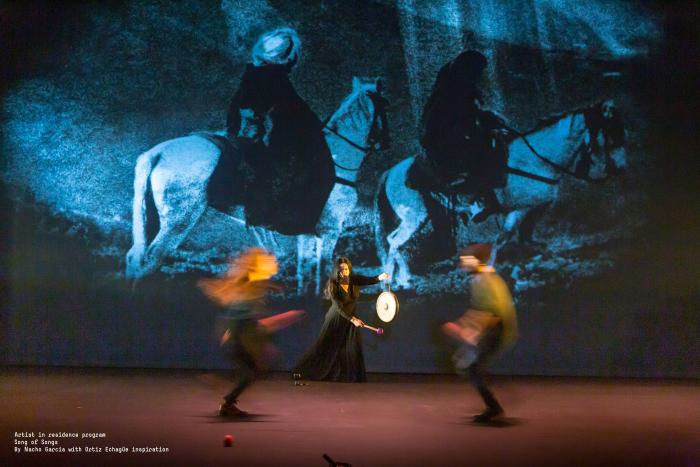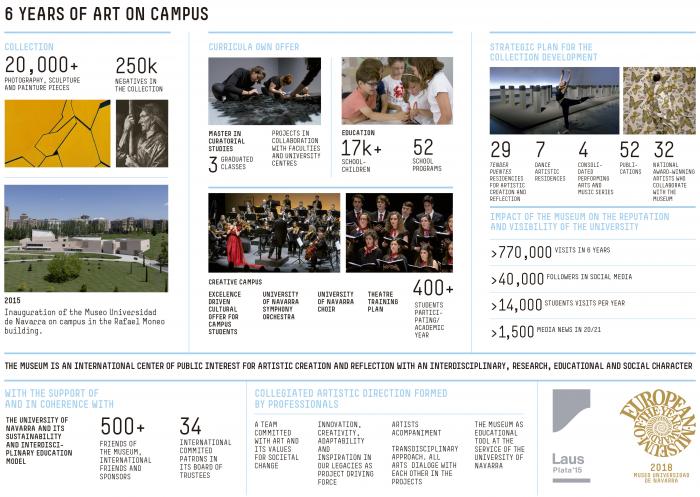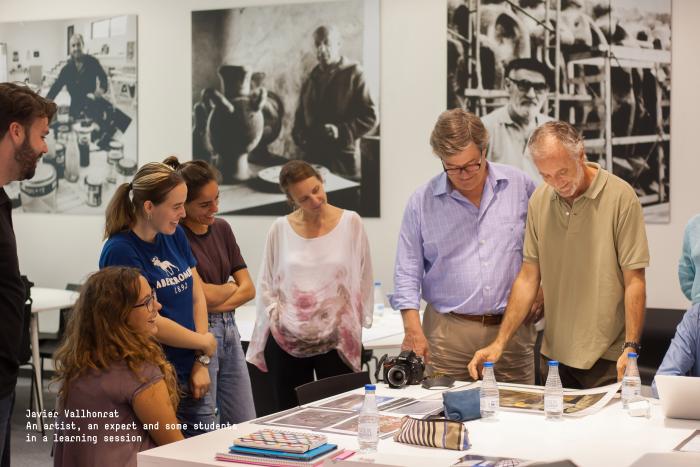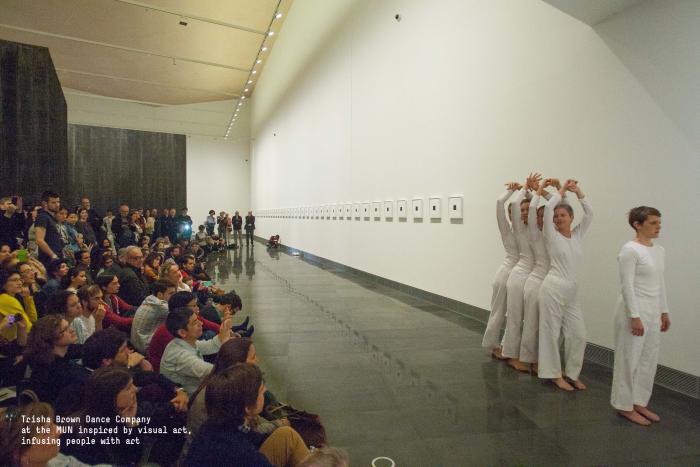I. SUMMARY INFORMATION
Project
268358
Status
Submitted
Award category
Preserved and transformed cultural heritage
You want to submit
NEW EUROPEAN BAUHAUS AWARDS : existing completed examples
Project title
Museo Universidad de Navarra (MUN)
Full project title
Museo Universidad de Navarra where legacies and art meets life
Description
In the heart of the Campus, the Museo is an open, hiving space where the collections inspire artists, the artists inspire participants and the society. Through an innovative program, based in our Collection and impulsed by the visual and the performing arts, the MUN and its transdisciplinary art approach upscales the legacies and transfers to the society -from schoolchildren to the eldest- the artistic tools, values and spirit aiming to improve life through art and its meaningful experiences.
Where was your project implemented in the EU?
Spain
Navarra
Ctra. de la Universidad s.n.
42.803571898155646
1.6575944884736138
Pamplona
31009
When was your project implemented?
Has your project benefited from EU programmes or funds?
No
Which programme(s) or fund(s)? Provide the name of the programme(s)/fund(s), the strand/action line as relevant and the year.
II. DESCRIPTION OF THE PROJECT
Please provide a summary of your project
The Museum was built in the heart of the Campus to contribute to the innovative education model proposed by the Universidad de Navarra that aims to educate our youth for an increasingly complex and internationalised world. Pointing up to excellence from a humanistic perspective and values, art was indispensable for training and education.
Two donations are at the origin of the project. The legacy of the engineer and photographer José Ortiz Echagüe and Mª Josefa Huarte’s collection on modern and abstract art. Apparently distant from one another, the experts team saw the intrinsic connection between photography irruption and modern and abstract movements, and aimed to bridge the gap between legacies and modern art.
Photography’s birth was a blend of technique, technological advances, art and the social need to document and represent societal progress. By its origin, photography strived to be considered an artistic discipline. In its path, its apparent objectivity in reality representation influenced the artistic movements' evolution.
In 2002 the curatorial team started the program TENDER PUENTES, inviting contemporary visual artists to be inspired by the collection for their own works. This coined a new methodology that bridged heritage and contemporary art production around the construction of the image. In 2016 the program was transferred and opened to choreographers and performative artists.
This way the Collection is alive as the most comprehensive legacy on photography done in Spain, a reflexive journey through the techniques and subjects of image from XIXth century to nowadays.
Since the Museum’s inauguration in 2015, the Collection and its transdisciplinary approach inspire a wide variety of initiatives and permanent research, educational and dissemination programs.
The year program enliven the students to include art in their daily routine, and offers programs for kids and schools, for every public, aiming to serve as a meeting point with art.
Please give information about the key objectives of your project in terms of sustainability and how these have been met
One of the focal points of the Collection, as settled by one of its main donors, Mrs. Mª Josefa Huarte, was to open art and art enrichment to anyone in society, in an inclusive way. She conceived art as a necessary life condition for personal growth, well in line with the innovative educational approach of the Universidad de Navarra.
Common art enjoyment generates societal cohesion,cultural enhancement and conflict diminishment, as well proven by numerous studies. Personal enrichment through contact with art is difficult to prove but entails evident social gain. The Museum’s strategic objectives for the legacies and collections includes a live and sustainable collection. From 32K initial pieces, the Museum has developed a collection of over 250K pieces of painting, sculpture and photography.
The program TENDER PUENTES allows society to get inspired in the past to face what is coming next. In this task, we count on the help of the artists’ view, their way to confront uncertainty, think out of the box creating new reflective spaces for a more sustainable future.
The upscaling way of boosting creation leads to a sustainable art system in terms of economy and investment. Artists and the institution invest together in the sustainability of the art sector leading to a system less dependent on institutional subsidies, built on common compromise.
The Museum has created a tight community around art and art creation stimuli, inspired in the past, in the deep comprehension of our common origins, sharing the values and the aim of future common growth.
The programs arisen around Tender Puentes, the collection & the Museum’s transdisciplinary art approach generates hybridization initiatives that transfer the findings on one discipline to another, to educational models and to art enjoyment and experience innovation, preserving the artistic nature and applying it to social growth in permanent dialogue with the publics of today, for the future society we are all building.
Please give information about the key objectives of your project in terms of aesthetics and quality of experience beyond functionality and how these have been met
The collection's strategic development plan set an ambitious service and completion goal, based on research and creation through legacies and heritage. The program TENDER PUENTES enhances contemporary creation inspired in the Collection, a relevant approach for current and future societies.
The successful new artistic accompaniment methodology coined by the program and transferred to performative art disciplines, has originated beautiful transdisciplinary creations who allows the public a multifaceted and reflexive artistic experience. The fluid transfer of knowledge in the artistic field based on the transdisciplinary dialogue enhances nearness as well as aesthetic quality and experience for artists and public alike.
The Master in Curatorial Studies designed by the Museum to train a new generation of art curators from European values, models and mental frames. It is based on the gained experience and aims to amplify its transdisciplinary and collection inspiration views into the future. 43 new curators are already developing their specific discourse enhancing art experience, comprehension and story to the public.
A research program around the Collection aims to transdisciplinary collaboration and conversation in the analysis about art (history of non-palatial arts, psychology and phenomenology of the creative process...), for art (the artistic praxis benefits from the research on other disciplines such as optics, big data…),and also on arts as an enlarged concept of the practice based research.
Yearly projects infuse education with art values and creativity as well as methodologies based on art practices inspired in our Collection.
Public Programs include collaborative and participative projects to establish a conversation with society. The solid digital strategy aims to become a value added content provider attracting new audiences and generations, merging technology and art to make the Collection and the activities around it available in an innovative way
Please give information about the key objectives of your project in terms of inclusion and how these have been met
The intrinsic inclusive nature of art experience overcomes barriers. Following Mrs.Huarte’s and donors mandate over 770K physical visits and an average of 380K yearly online visitors have taken part in the proposed art experience in its 6 years existence.
In terms of gender perspective, the figure of Mª Josefa Huarte has been key to the project development. The majority of women amidst the MCS students will also influence the future art discourse and mediation. At least one female artist per year has participated in temporary exhibitions and artistic residences programs.
Art is for everyone. From high capacity children, to the elder, experts, people with disabilities or special needs, less favoured and university students find in the Museum a place where art is a barrierless language. The artistic language is a clear way to incorporate new findings and learnings, a place to be heard and to imagine artistic experiences. This year, and thanks to the private-public collaboration agreements, the Museum has held over 40 programs adapted to public segments with specific sensorial or intellectual needs, and the complete educational program devoted to Schools, have tackled subjects such as circular economy, recycling, self-image or the role of women inspired in the collection & the exhibition VIK MUNIZ.
Art improves life. Based in this convincement, this year 2021 and attending to the current pandemic situation, the Museum has designed a collaborative program where all artistic disciplines, assisted by technology, offered experiences in the form of workshops with art therapists, conferences on artistic disciplines and emotional impact, as well as spectacles consisting in music and performances, experience writing or a participative theatre experience. QuidARTE initiative, served 1,325 people in in-person mode over 30 % of them sanitary sector staff and people over 60 and over 6,500 through streaming, helping them to take care of their emotions through art.
Please give information on the results/impacts achieved by your project in relation to the category you apply for
Since their start, 36 visual artists from different disciplines have become part of the program TENDER PUENTES and the Creative Residences Program opportunity. They have promoted art performances inspired on real events (i.e. about the pandemia A puerta cerrada a trilogy in hybrid format, based on Las Roncalesas, a Ortiz Echagüe picture dated ca 1920, or A metro y medio (dance)) for social reflection, as well as an innovative book collection on performative arts creative process, Cuadernos de Creación.
By 2017 already 60% of the doctoral thesis produced in the Universidad de Navarra on photography, were generated since the Museum inauguration in 2015 (Deloitte independent report).
During the school year 20-21, 1,160 students and university staff took part in over 52 teaching events organised in the Museums spaces (exhibition rooms, classrooms, workshops…). A significant experience inspired by the legacies that merged art with medicine, pharmacy, architecture, design, communication, philosophy… where art served as a reflection and learning tool.
43 new curators trained at MCS consolidate a future approach to art curation, based on the legacies, the transdisciplinary approach and European values.
Over 39 % of the visitor public is under 35, a rejuvenation of the social basis attending museums. Art and legacies based innovative learning program that has served 17K school children since 2015. The Museum’s Collection and exhibition programs attract art based tourism from all over the world (average 20 % until 2020).
Around MUN a growing community of professionals from different disciplines work in a place where art can move us together into the future, getting inspired by our legacies and artistic creation findings.
The transfer from the artistic process and language findings to society in any field, has opened different working lines with enterprises and research centres as well as other faculty centres in the university and the society.
Please explain the way citizens benefiting from or affected by the project and civil society have been involved in the project and what has been the impact of this involvement on the project
Since Tender Puentes started, the artists and artistic community have been involved in considering our legacies as a creative source. This has meant an innovation in the cultural offer scenario, and has enriched their view, the collection and the interpretation of our heritage, and has coined a singular methodology.
The methodology and transdisciplinary approach to art, has allowed the transferral of the program to other artistic disciplines, bridging the distance between artistic languages and leading people to think that it can also link the gap between art and other life fields. Legacies and heritages are able to inspire despite our cultural background in many different ways that should be researched.
The campus community has gained a place to meet with art, adding this important dimension to the all-round moulding of individuals and the fostering of a critical social conscience in life and for life. Art is present in their daily lives as experience, learning and reflection opportunity.
Regionally, the Museum has become one of the first cultural centres in terms of visits and activities. An innovative and singular centre present in the local cultural scenario that enriches the territory. The museum activities, workshops, conferences… gather a growing community of art interested and passionate citizens that impacts social life.
In terms of tourism, the Museum attracts visitors from all over the world, enhancing the regional tourist offer and economy.
The strong relationship with teachers enlarges every year the number of schoolchildren who participate in the educational programs designed around the collection, legacies and art.
The Museum benefits from art as an international language, has an impact on education at any age level, social cohesion and regional international image. It is also weaving long lasting relationships with local, regional, national and international actors, giving birth to enriching collaborative models.
Please highlight the innovative character of the project
The Museo Universidad de Navarra is a different museum in many aspects. Its legacies and collections are an inspiration and creative source that opens Art and its experience to everyone, bridging heritage and future.
It is a Museum with a theatre, a place where every artistic expression establishes a dialogue with other artists and disciplines generating a common and hybrid set of experiences, that can also get inspired in our legacies, updating the collection not just in the visual art field, but in other areas.
The team develops a yearly program that invites every individual to come and meet art at the Museum. A program that encourages offering the research and the application of their findings to other fields such as education, students and professional development, self-care, self-image and steem…
As a university centre, the Museum offers a Master in Curatorial Studies. A program where the students learn how to curate art by a “learning by doing” methodology, from european values and perspective by accompanying the Museum's life.
Due to its transversal approach the knowledge transfer is inserted in its ADN. Hence, the Museum is starting to develop a project in collaboration to research the possibilities of transferring art creativity processes and languages to the enterprise and entrepreneurial environments, to learn from art with this methodology, in order to innovate in other more structured or procedimented fields.
The innovative character of the project gush up from the very idea of placing a centre devoted to art in the middle of the Campus. The project is run by a collegiate board with strong bonds with artists who work together in order to bring the essence of every discipline into each single initiative to add the value of the interdisciplinarity, the transversal approach and the universal impact of art into the lives of everyone.
Please explain how the project led to results or learnings which could be transferred to other interested parties
The 20 years experience in the artistic residences program, has coined a specific methodology that could possibly be applied successfully to other fields. Two multinational enterprises have expressed their interest in experimenting with this approach to apply the artists’ points of view and ways to solve practical problems to enrich their team's work.
The artists in residence are invited to register and express their ideas and working processes in the form of a book. This has given birth to two collections of titles as reflection texts on artistic personal processes.
The education team is successfully applying active and collaborative methodologies based on art experience in different school grades, in different group typologies, and even in different cultures, now through online technologies, that could be adapted to diverse scenarios.
Campus Creativo, the team specifically devoted to the university students group, has developed projects on art, innovation and creativity. Through creativity and participative methodologies, technology, concepts and experiences, supported by research experts, a group of students of different faculties were mentored to solve real societal problems detected by them. The promising results of this pilot program could easily be transferred to other universities.
The Museum’s trajectory has given birth to a transdisciplinary, participative and research approach to art and the artistic phenomena based in our heritage and legacies still in an open and ongoing discussion process.
The sustainability of a project in the culture sector -based on excellence and binding contemporary problems and views with tradition and legacies, can also be shared as inspiration to other cultural impact institutions.
The Museum’s view and approach infusing art in every aspect can also be transferred not only to cultural entities but also to those who actively prototype and act to face complex situations in their daily decision making.
Is an evaluation report or any relevant independent evaluation source available?
III. UPLOAD PICTURES
IV. VALIDATION
By ticking this box, you declare that all the information provided in this form is factually correct, that the proposed project has not been proposed for the Awards more than once under the same category and that it has not been subject to any type of investigation, which could lead to a financial correction because of irregularities or fraud.
Yes





